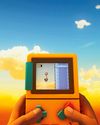
Time has shattered in Quantum Break. As Jack Joyce, beneficiary of one of those laboratory explosions that bestow so many superheroes with their powers, you spend much of the game wandering around stuttered instants that have pressed pause on reality. So it’s apt that revisiting the game now feels like stepping back into a very specific moment, one that’s been preserved in amber.
Quantum Break was unveiled alongside Xbox One, at a press conference that’s mostly remembered as an hour-long stumble for Microsoft. The event put the emphasis on the console’s intertwining with television, and brought in Steven Spielberg to reveal a Halo live-action series. This was May 2013, right at the peak of Xbox Entertainment Studios, Microsoft’s attempt at venturing from Redmond into LA, and a month after the launch of Defiance, which was simultaneously a Syfy TV show and a Trion Worlds MMO.
Factor in Remedy’s own fascination with television, something that had been evident since Max Payne squeezed a Twin Peaks homage onto cathode-ray sets scattered through its levels, and Quantum Break starts to make sense. Well. More sense. After all, this is not only a game which incorporates a live-action TV show, it’s also a convoluted time-travel narrative with a fractal approach to storytelling, a tripartite structure, and a sprawling cast who rarely cross over between those parts. Not that this was all apparent that night on the Xbox campus.
This story is from the {{IssueName}} edition of {{MagazineName}}.
Start your 7-day Magzter GOLD free trial to access thousands of curated premium stories, and 9,000+ magazines and newspapers.
Already a subscriber ? Sign In
This story is from the {{IssueName}} edition of {{MagazineName}}.
Start your 7-day Magzter GOLD free trial to access thousands of curated premium stories, and 9,000+ magazines and newspapers.
Already a subscriber? Sign In

NO MORE ROOM IN HELL 2
You're not alone in the dark

WINDBLOWN
Life after Dead Cells

COLLECTED WORKS - JOSH SAWYER
Journeying to the Forgotten Realms, Infinity and beyond with the RPG veteran

SCREENBOUND
Going deep in a mind-bending hybrid of perspectives

Trigger Happy
Shoot first, ask questions later

Grand strategist
Paradox's Mattias Lilja addresses the publisher's recent difficulties - and the plan to right the ship

Diablo IV
A progress report on the games we just can't quit

Ghosts 'n Goblins Resurrection
In Capcom's diabolical tribute, evil goes far deeper than the demons on the screen

SERENITY FORGE
How a near-death experience lit a fire in the Colorado-based developer and publisher

THE MAKING OF...ALIEN: ISOLATION
How a strategy-led studio built a survival horror masterpiece in Ridley Scott's image